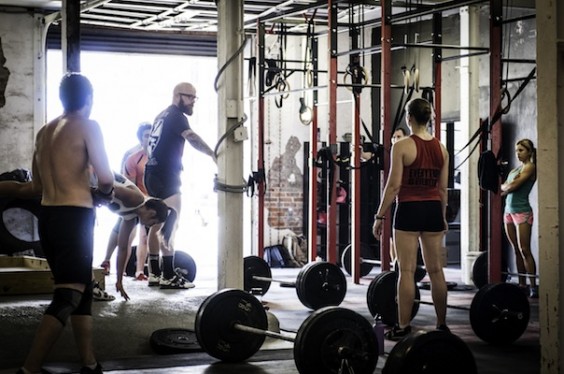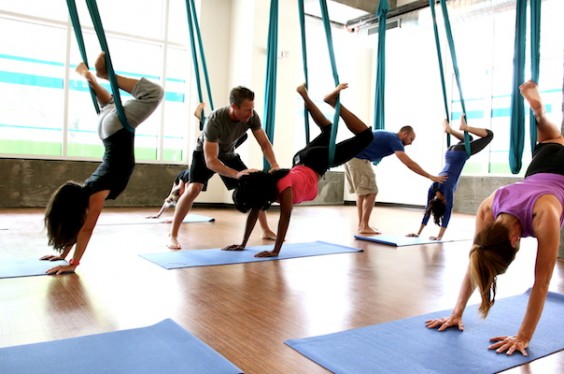 Want to Look Better? Want Results Faster? Want More Motivation? Here’s the Solution: Lift Heavy and Get Strong(er).
Want to Look Better? Want Results Faster? Want More Motivation? Here’s the Solution: Lift Heavy and Get Strong(er).
Back in the day the primary focus and reason for weight training was to get stronger. Just think about that for a second. That is a much different reason than why people join gyms in this day and age. For whatever reasons, the focus has undoubtedly switched from getting stronger to just looking better.
Here’s a quote from Brooks Kubik’s book Dinosaur Training on this very same topic:
. . . they always looked better as a result of their training, but gains in appearance were viewed as a natural by-product of training for strength (my emphasis). You trained for strength and you ended up looking better as a by-product of your strength training. You didn’t train to look better.
Now there is absolutely nothing wrong with wanting to look good. Heck, it’s nice to feel confident in a swim suit, in your clothing, and when you’re naked. But my concern is that most people focus too much on looking good, and that is solely what drives their weight training goals.
Here is something most people fail to realize, and it’s the driving force behind Fat Loss Detour – if you focus your efforts in the gym on getting stronger and improving your performance in big, compound exercises and you eat smart CONSISTENTLY, your physical appearance and body composition will change for the better.
Yes, it really is that simple.
I no longer concern myself with training for pure aesthetics. I’ve been there and done that, and the results weren’t near as great as what I achieve now. My main focus when I am in the gym is not on “toning up” or “shaping” my body; it’s on getting stronger. My priority at the gym is to either:
- Put more weight on the bar.
- Perform more reps with the same weight.
And the best part about focusing on those two things is that they will force my body to change for the better aesthetically without me directly intending to do so. As long as I’m eating properly and resting, my body composition does, and will continue, to improve.
Another great thing about training for strength: it is much more motivating and enjoyable than simply training to look good. Well, at least in my opinion, and those of the people I train.
Think about it. What’s more motivating? Setting a new personal record in the deadlift, or going through the motions and just getting the workout over with hoping you see the fruits of your labor in the near future?
With all that said and out of the way, let’s delve a little deeper into the whole “Lift Heavy. Get Strong(er) and Look Better” title at the beginning of this post.
What Do I Mean by “Heavy”?
First of all, the term “heavy” means different things to different people. Conventional deadlifting 255 pounds for four reps is heavy for me. But, for some people that would be considered light weight. “Heavy” is a relative term depending on the individual and the exercise being performed.
When I tell people to train “heavy”, I simply mean use as much weight as possible for a given exercise for the prescribed reps with perfect form. It doesn’t matter if you’re performing a set of triples on the deadlift or 10 reps on overhead presses. Just make sure you are working very hard with whatever weight you are capable of using.
What Exercises Will Get Me Strong(er) and Make Me Look Better?
This is something I have mentioned on numerous occasions, and one being Back to Basics for Better Results. Here’s a fact for you: if you had nothing to use for your training except a barbell, some weight plates, a bench, and a power rack, you could get far better results than 99% of people who have access to fully equipped gyms.
Too many people get so caught up with the “latest and greatest” exercises (I’ve been guilty of this myself) that they lose sight of what will help them achieve great results in the least amount of time – hard work on the basics! They begin to suffer from “paralysis from analysis” because “this trainer said to do this”, and “this trainer said I have to do that”, and “this is the latest and greatest training technique”, and what ever else it’s popular at the moment.
Well, here is something the vast majority of great trainers and strength coaches would agree on: the basics are what matter most and what will deliver the greatest results. Yep, that’s right. Nothing is ever going to replace squats, deadlifts, presses, rows, chins, and dips. (Note: yes I am vividly aware of the fact that some people have limitations that keep them from being able to squat and/or dealift properly. However, most people can, and should, squat and deadlift).
If you have limited time to train or simply want the “biggest bang for your training buck”, then you need to focus on the basics. Forget about the specialty exercises for the time and bust your butt on those primaryexercises. You won’t be disappointed.
Let me put it another way: if you train hard, increase the weight you use for your exercises, and train consistently on the basic exercises, and you are eating smart, then you will have a body that most people will only dream of achieving. AND you’ll do it in much less time than you might think is possible.
There’s a reason for you to focus on the big, basic, compound exercises mentioned above – because they work! And there is a simple explanation for why I don’t tell you to work hard at isolation exercises such as triceps kick-backs, cable pec flyes, leg extensions, lateral raises, and other isolation movements – because they are NOT nearly as effective as the basics.

Brooks Kubik once again sums things up nicely in Dinosaur Training on why you can’t build a strong and great looking body with nothing but isolation exercises:
If you don’t believe me, then train for three months on a program that consists of nothing but leg extensions, leg curls, pec deck movements, concentration curls, and tricep kickbacks . . . After that period of time, train for three months on a program where you do nothing but bench presses, squats, and pull downs on Monday and nothing but presses, deadlifts, and curls on Thursday . . . At the end of the second three month period you will be enormously bigger and stronger than when you started the program. The first program will be a waste of time while the second program will be very productive, solely because you have focused your attention on the important exercises.
Here’s a quick note for all of the ladies who read the “enormously bigger and stronger” part and freaked out – that message is for men, and Dinosaur Training is written for men. However, I train with the same big, basic exercises and train as heavy as possible, and so the women that I train. No one, and I repeat, no one, has gotten “enormously big” or “big” in any negative use of the term when applied to a female. In fact, they look far better when training in this manner than they did when following the typical “women friendly” workouts that are so prevalent in magazines, books, and TV shows today. Ladies, heavy lifting with the basic exercises is your ticket to a better looking body. If that wasn’t true, then I would be out of a job.
Tony Gentilcore had an excellent post on this the other day, and if you want more information about lifting heavy and NOT getting big and bulky, you can check it out here.
Bottom line: man or woman, training hard and heavy with the basics WORKS.
Why YOU Should Train for STRENGTH
This is something I go in depth about in Fat Loss Detour, and it is something I feel very strongly about. But the question remains: why should you train for strength, even if your only concern is to look better in a swim suit?
Simple: because it’s a sure fire way to actually make progress in the gym, and making progress through improved performance in the basic exercises is the fastest and most effective way to transform your body. Combine that with smart eating principles and you will be well on your way to building not only a great looking body, but a strong body as well. What could be better than that?
Look. There is no stock or secret club for hard and heavy training with basic exercises. I have no ulterior motive in making these suggestions. I am sharing with you the information that I have seen produce results time and time again, without fail. If wimpy isolation exercises would transform your body, I would tell you to do them. But I’m not here to lie to you or give you warm, fuzzy feelings about changing your body. If you want results, you’re going to have to work HARD on the basics.








 Want to Look Better? Want Results Faster? Want More Motivation? Here’s the Solution: Lift Heavy and Get Strong(er).
Want to Look Better? Want Results Faster? Want More Motivation? Here’s the Solution: Lift Heavy and Get Strong(er).
 Brooks Kubik once again sums things up nicely in Dinosaur Training on why you can’t build a strong and great looking body with nothing but isolation exercises:
Brooks Kubik once again sums things up nicely in Dinosaur Training on why you can’t build a strong and great looking body with nothing but isolation exercises: